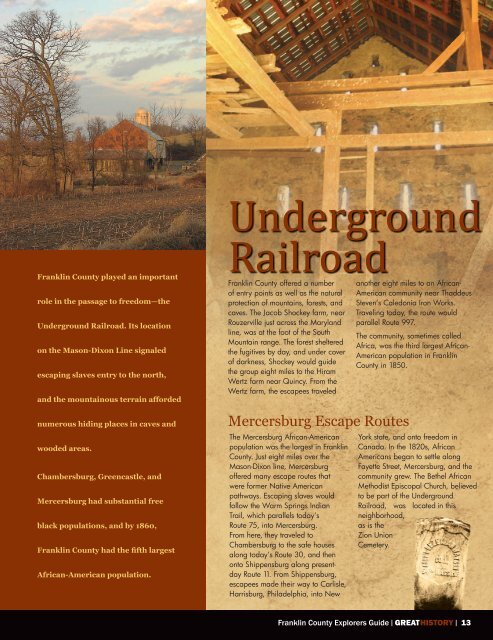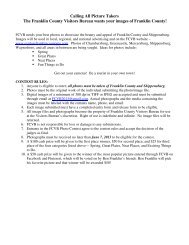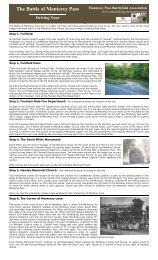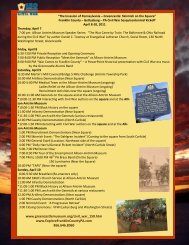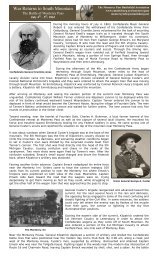Underground Railroad Brochure - Explore Franklin County | PA
Underground Railroad Brochure - Explore Franklin County | PA
Underground Railroad Brochure - Explore Franklin County | PA
You also want an ePaper? Increase the reach of your titles
YUMPU automatically turns print PDFs into web optimized ePapers that Google loves.
<strong>Underground</strong><br />
<strong>Franklin</strong> <strong>County</strong> played an important<br />
role in the passage to freedom—the<br />
<strong>Underground</strong> <strong>Railroad</strong>. Its location<br />
on the Mason-Dixon Line signaled<br />
escaping slaves entry to the north,<br />
and the mountainous terrain afforded<br />
numerous hiding places in caves and<br />
wooded areas.<br />
Chambersburg, Greencastle, and<br />
Mercersburg had substantial free<br />
black populations, and by 1860,<br />
<strong>Franklin</strong> <strong>County</strong> had the fifth largest<br />
African-American population.<br />
<strong>Railroad</strong><br />
<strong>Franklin</strong> <strong>County</strong> offered a number<br />
of entry points as well as the natural<br />
protection of mountains, forests, and<br />
caves. The Jacob Shockey farm, near<br />
Rouzerville just across the Maryland<br />
line, was at the foot of the South<br />
Mountain range. The forest sheltered<br />
the fugitives by day, and under cover<br />
of darkness, Shockey would guide<br />
the group eight miles to the Hiram<br />
Wertz farm near Quincy. From the<br />
Wertz farm, the escapees traveled<br />
Mercersburg Escape Routes<br />
The Mercersburg African-American<br />
population was the largest in <strong>Franklin</strong><br />
<strong>County</strong>. Just eight miles over the<br />
Mason-Dixon line, Mercersburg<br />
offered many escape routes that<br />
were former Native American<br />
pathways. Escaping slaves would<br />
follow the Warm Springs Indian<br />
Trail, which parallels today’s<br />
Route 75, into Mercersburg.<br />
From here, they traveled to<br />
Chambersburg to the safe houses<br />
along today’s Route 30, and then<br />
onto Shippensburg along presentday<br />
Route 11. From Shippensburg,<br />
escapees made their way to Carlisle,<br />
Harrisburg, Philadelphia, into New<br />
another eight miles to an African-<br />
American community near Thaddeus<br />
Steven’s Caledonia Iron Works.<br />
Traveling today, the route would<br />
parallel Route 997.<br />
The community, sometimes called<br />
Africa, was the third largest African-<br />
American population in <strong>Franklin</strong><br />
<strong>County</strong> in 1850.<br />
York state, and onto freedom in<br />
Canada. In the 1820s, African<br />
Americans began to settle along<br />
Fayette Street, Mercersburg, and the<br />
community grew. The Bethel African<br />
Methodist Episcopal Church, believed<br />
to be part of the <strong>Underground</strong><br />
<strong>Railroad</strong>, was located in this<br />
neighborhood,<br />
as is the<br />
Zion Union<br />
Cemetery.<br />
<strong>Franklin</strong> <strong>County</strong> <strong>Explore</strong>rs Guide│GREAT MOMENTS│ HISTORY│ 13
William Still<br />
an African American active<br />
in anti-slavery activity<br />
William Still, an African<br />
American active in anti-slavery<br />
activity, compiled a catalogue<br />
of stories of escaping slaves<br />
that made their way to<br />
Philadelphia’s Anti-Slavery<br />
Offi ce and Vigilant Committee.<br />
This account is excerpted from<br />
The <strong>Underground</strong> <strong>Railroad</strong>,<br />
and is to have taken place in<br />
May 1859 with Chambersburg<br />
a central location.<br />
“It (the party) consisted of a<br />
colored man, a white woman,<br />
and a child, ten years old. David,<br />
the colored man, was about<br />
twenty-seven years of age,<br />
intelligent, and was owned, or<br />
claimed by Joshua Pusey. David<br />
had no taste for slavery.<br />
So after thinking of various<br />
plans, he determined not to run<br />
off as a slave with his “budget<br />
on his back,” but to “travel as a<br />
coachmen,” under the “protection<br />
of a white lady.”<br />
On reaching Chambersburg, Pa.,<br />
in the evening, they drove to a<br />
hotel, the lady alighted, holding<br />
by the hand her well-dressed and<br />
nice-looking daughter, bearing<br />
herself with as independent an<br />
air as if she had owned twenty<br />
such boys as accompanied<br />
her as coachman. She did not<br />
hesitate to enter and request<br />
accommodations for the night,<br />
for herself, daughter, coachman,<br />
and horse. Being politely told that<br />
they could be accommodated,<br />
all that was necessary was, that<br />
the lady should show off the best<br />
advantage possible. The same<br />
duty also rested with weight<br />
upon the mind of David.<br />
The night passed safely and<br />
the morning was ushered in<br />
with bright hopes which were<br />
overcast but only for a moment,<br />
however. Breakfast having<br />
been ordered and partaken of,<br />
to the lady’s surprise, just as<br />
she was in the act of paying<br />
the bill, the proprietor of the<br />
hotel intimated that he thought<br />
that matters “looked a little<br />
suspicious,” in other words, he<br />
said plainly, that he “believed<br />
that it was an <strong>Underground</strong> Rail<br />
Road movement;” but being an<br />
obliging hotel-keeper, he assured<br />
her at the same time that he<br />
“would not betray them.” Just<br />
here it was with them as it would<br />
have been on any other railroad<br />
when things threaten to come to<br />
a stand; they could do nothing<br />
more than make their way out<br />
of the peril as best they could.<br />
One thing they decided to do<br />
immediately, namely to “leave<br />
the horse and carriage,” and<br />
try other modes of travel. They<br />
concluded to take the regular<br />
passenger cars. In this way<br />
they reached Philadelphia. In<br />
Harrisburg, they had sought and<br />
received instructions how to find<br />
the Committee in Philadelphia.”<br />
14 │GREAT HISTORY│www.explorefranklincountypa.com
African American<br />
COMMUNITY<br />
Supports <strong>Underground</strong> <strong>Railroad</strong> in Chambersburg<br />
A<br />
historic marker on Memorial Square marks the <strong>Underground</strong> <strong>Railroad</strong><br />
activity of Chambersburg. Many of Chambersburg’s African-American<br />
citizens participated in the <strong>Underground</strong> <strong>Railroad</strong> and the majority<br />
of the African-American population was concentrated in the South Ward. Henry<br />
Watson, a local barber, and Joseph Winters, an inventor and author, were two<br />
known agents of the <strong>Underground</strong> <strong>Railroad</strong>.<br />
In August, 1859, abolitionist Frederick Douglass visited Chambersburg.<br />
When he was recognized by the townspeople, he was pressed to give a speech.<br />
The speech was given in a building on the square called the <strong>Franklin</strong> Repository,<br />
since burned in the 1864 Civil War Burning of Chambersburg. The site is<br />
adjacent to the 1865 <strong>Franklin</strong> <strong>County</strong> Courthouse that remains today. Douglass’<br />
true purpose for traveling to Chambersburg was not a speaking engagement,<br />
but a meeting with John Brown, who<br />
had written him asking to meet in<br />
Chambersburg. The meeting was held<br />
in an old quarry in the area behind the<br />
present-day Southgate Shopping Center.<br />
Douglass was unable to dissuade Brown<br />
from his plan to take hold of the Harpers<br />
Ferry arsenal.<br />
16 │GREAT HISTORY│www.explorefranklincountypa.com


